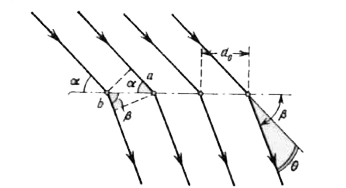A plane wave falls on a diffraction grating with a grating constant d0 at a glancing angle α. Prove that the resulting diffraction will be the same as when the wave falls normally on a grating with a grating constant of d = d0sinα.
Let a paralle heam. That is a plane wave, fall on the grating at a glaneing angle of α (Fig. 40.14). The direction of the zero - order interference maximum will obviously be the same. As to the maximum of order m, its direction will be at a glancing angle β, so that the propagation difference is Δa−b=mλ. Noting that a=d0cosα,b=d0cosβ, where d0 is the grating constant, we obtain
d0(cosα−cosβ)=mλ
This is just the condition for the interference maxima when the light rays are incident at an angle to the diffraction grating. Now let us express the interference condition for the angle θ equal to the deflection angle of the diffraction maximum from the original direction of the beam. Since β=α+θ, it follows that
cosα−cosβ=cosα−cos(α+θ)=cosα−cosαθ+sinαsinθ
Since the angle θ is usually very small, cosθ≈1, and cosα−cosβ≈sinαsinθ. The condition for the maximum assume the from
d0sinαsinθ=mλ
i.e. the instrument behaves with respect to the inclined beam in the way it would have done if a grating with constant d=d0sinα were placed perpendicular to the rays.

Similar Questions
Light with wavelength λ falls on a diffracting grating at right angles. Find the angular dispersion of the grating as a function of diffraction angle θ.
View SolutionFind the wavelenght of monochromatic light falling normally on a diffraction grating with a grating constant of 2.20 mu m,ifthe∠betweendirectionsofthefirst−andthesecond−ordermaximais15.0^(@).
View SolutionLight of 530 nm wavelenght falls on a grating with a grating constant of 1.50 μ m. and with a total length of 12.0 mm. Find the angular width of a principal maximum and the resolving power of the grating.
View SolutionLight with wavelength 530nm falls on a transparent diffraction grating with period 1.50μm. Find the angle, relative to the grating normal. At which the Fraunhofer maximum of highest order is observed provided the light falls on the grating
(a) at right angles,
(b) at the angle 60∘ to the normal.
View SolutionDemonstrate that when light falls on a diffracting grating at right angles, the maximum resolving power of the grating cannot exceed the value l/λ, where l is the width of the grating and λ is the wavelength of light.
View SolutionA monochromatic beam falls on a reflection grating with period d=1.0mm at a glancing angle α0=1.0∘. When it is diffracted at a glancing angle α=3.0∘ a Fraunhofer maximum of second order occurs. Find the wavelength of light.
View SolutionA narrow beam of X-rays falls at a glancing angle of 20∘ on a diffraction grating with a constant of 2.0 μ m. The first diffraction maximum is observed at an angle of 12' to the direction of the beam. Find the wavelenght of the X-rays
View SolutionA plane transmissio grating when illuminated with normal light produces a second order diffraction at 30∘ for wavelength λ=500 Å. Calculate the number of lines per cm on the grating.
View SolutionRadiation of atomic hydrogen falls normally on a diffraction grating width l=6.6mm. The 50th line of the Balmer series in the observed specturem is close to resolution at a diffraction angle θ (in accordace with Rayleigh's criterion). Find the angle.
View SolutionA plane light wave falls on Fresnel mirrors with an angle α=2.0 between them. Determine the wavelength of light if the width of the fringe on the screen Δx=0.55mm.
View Solution
